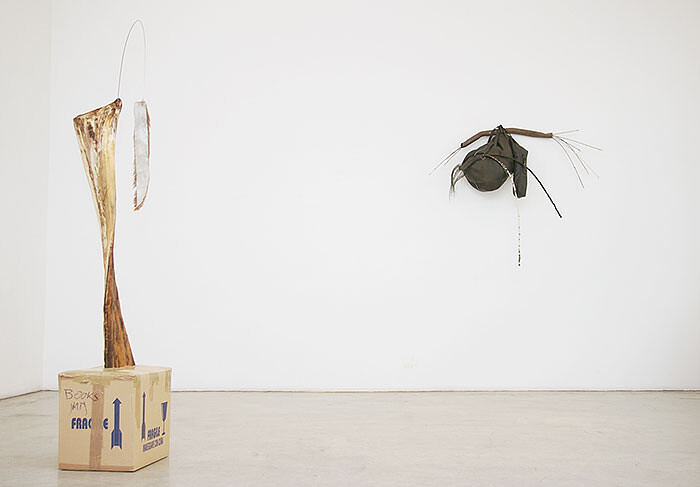An artist’s best consigliere is often another artist, a partner in crime who follows the adventurous path of an undefined yet malleable future. Chance encounters often lead to influential long-lasting relationships. Youthful firebrands grow canny to become wizard practitioners of subversive unorthodoxies. Such is the case in “looking at my own work (and his),” a joint exhibition of two long-time friends of thirty-plus years, Ricardo Brey and Jimmie Durham.
With wily self-control and daft humor these two shamans have produced a bricolage of objects that underscore the exhibition’s premise that is more of a dialogue than a collaboration. That is, one artist observing another, responding in kind to unconventional thinking. Apropos of the Freudian city, Brey and Durham have produced a bracing repartee of predominantly sculptural works.
Along with numerous iconic sculptural pieces from the early 2000s to 2011, Brey shows a few two-dimensional works from 2003. They’re part of a series on flight that are a continuation of his cosmological compendium of a thousand drawings that became a hefty 500-page tome called Universe. From bees, to bugs, to birds, the yellowish hue of the mixed media on rice paper are made to appear as archival specimens that German naturalist Alexander von Humboldt might have assembled and documented. Durham, on the other hand, acting as a foil, has responded with several witty new works from 2012.
Emphasizing symbiotic opposites in the works (soft/hard, jagged/smooth, light/heavy, cerebral/jocular) the artists have provided an insightful text that intimates a way to read the show. Keeping in mind that both have a well-documented connection to anthropology, writing, performance, and poetry, this cues the viewer into their line of thinking: “In Ismailin thought all texts have one interior or hidden meaning—Batini—and, in contrast, one exterior or apparent meaning—Zahir—sometimes the things start to be very complicated and the interior meaning also creates one external meaning, and like this the process goes on like infinity mirrors that reflect the interior and the exteriors forever.”
And so it is that these combines and readymades (or ready-add-ons, if you will) with their built-in art history turn into spookily charismatic representations of otherness. An indigenous American take on modernity, Homage to Brancusi #4 (2012) is a mixed media jerry-built totem, its taped cardboard box base with a curvy piece of driftwood holds a wire extending outwardly with a cow pelt at its very tip.
Nearby mounted on the wall is a large thick rubber and chain cocoon called Ungrund (2009–2011). Stacked and nuzzled inside of its vulva-shaped orifice are dozens of obfuscated images (perhaps naturalist reproductions) glued onto cardboard supports. It’s hard to make out what they are since the top ones are muddied with pigment and plaster caked all over; either an homage to Anselm Kiefer’s monumental encrusted forms or a friendly elbow to his ascetic ribs.
Perhaps My life in the ghost forest (2010) (compiled of rubber, chains, traditional African ceremonial cloth, mirrored sunglasses, cowry, a type of smooth shiny mollusk shell) is a proxy high priest lording over the exhibition to offer its benediction. If so then Brey has fared well with Damselfly (2010), a beat-up leather guitar case, iron pipe, elephant tail, pearls, and buttons that are whimsically ornamental. The soft sculpture alludes to the rhythmic movements of ceremonial ritual and the improvisatory elements in jazz music as analogous to art making itself.
Each artist’s vocabulary is a dyslexic transmigratory expression grafting Paleolithic associations (animal pelts, stones) with Modern industrial remnants into a punctiliously sound present-day conceptual praxis. By now the exoticized ritualistic Afro-Cuban and Native American totems running throughout their oeuvre is a moot point. Moving the discussion forward from nomadism, there’s a latent punk edge (especially with Brey albeit less pugnacious) surprisingly connecting them to 80s artists such as David Wojnarowicz, Mapplethorpe, and Alan Suicide, right on up to David Hammons. Their metamorphosis of salvaged materials is in line with younger artists working today. (Simon Starling immediately comes to mind as one who dexterously re-contextualizes the constituent history, meaning, and function of objects.)
Brey is based in Ghent, while Durham lives between Rome and Berlin: but in Vienna they are dancing another type of waltz for the audience uninitiated to their hunter-gatherer voodoo. These seen-it-all artists have the ability to thread folkloric tradition and anthropology, with contemporary art’s own brand of remixing.
Hiding in a corner of the second gallery space next to Durham’s 1998 late-Picasso style graphite double self-portrait Do You Love Me? sits a lonely icon on a pedestal: a square cobblestone wrapped around one side with a magenta and red canvas (Home at Last [2012]). This painting-sculpture hybrid has shades of neo-geo and Rothko sublimity.
Beneath the pavement of Vienna’s old center lie many artifacts and stone ruins from the era of Roman rule. Ancient civilization, after all, was built upon stone, which also had commemorative and ceremonial purposes: stone meant many different things to everyone, from anarchists to masons, and Durham’s work shows that he understands its metaphorical allusions. Here the placement of the stone is a knowing archeological wink to Vienna’s antique past while Brey’s sculptures look like the heraldic of a punk witch doctor dispelling bad spirits. Together they’ve given us a potent one-two punch, a moment of talismanic transcendence.




